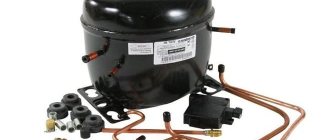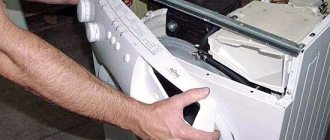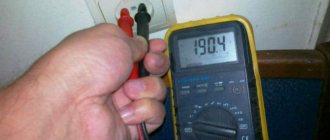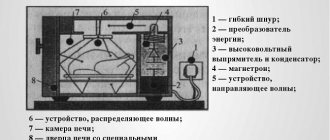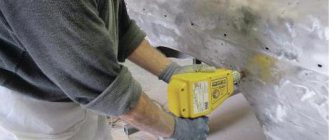This household appliance is an indispensable assistant for the housewife in the kitchen: with the help of a microwave you can quickly heat up food prepared the day before, as well as stew vegetables and meat products, make original hot sandwiches and much more. Like all appliances, the furnace can break down, and the most common problem is that a fuse blows due to a power surge. We will tell you in detail what kind of fuses there are in a microwave oven, and also provide a replacement algorithm.
How many are there in the microwave?
The microwave is protected by three fuses.
- Network defender. This type of fuse is located at the power input and protects the entire device from possible voltage surges, which are not uncommon in our city networks. It also protects your home network from short circuits that may occur inside the oven. As a rule, it has a high potential - up to 12A, and if various malfunctions occur inside the product, the microwave instantly disconnects from the network.
- The high-voltage version serves as a protection element for the magnetron, protecting the high-voltage transformer from possible overloads. It is located nearby, and according to the diagram it is designed to break the circuit between the input and output of the high-voltage unit. Such circuits in technology are constantly subject to exceptional safety requirements, therefore all conductors of the high-voltage circuit are double insulated, and the safety element itself is enclosed in a separate housing made of hard plastic, which has different shapes and colors. It consists of two halves connected by a jumper and latches - they prevent spontaneous opening of such an original container. To replace the fuse, you need to release the latches, remove the part with the burnt core and insert a new element.
- Another fuse of a similar class is installed only on microwave models with an electronic control panel, which is powered from a low-power power transformer. It converts electrical current from the home network into the voltage needed to power electronic circuits. A separate circuit protector is at the same time a structural element of the entire unit, or, in language understandable to the user, it is located on top of the primary winding and is covered with special insulation, so it is quite difficult to change it. If you have a Samsung oven, then this part is located separately - on the control panel board, which makes the work much easier.
The instructions for the equipment will help you find out which fuses are on your stove model. Many modern models of microwave ovens do not have high-voltage fuses - manufacturers simply do not install them during manufacturing at the factory, so all their functions are performed by the network protector. But it burns out if there is a problem in the magnetron circuit only when the transformer is subjected to double load for quite a long time.
Such impacts negatively affect the transformer, and quite often lead to its premature failure.
Another interesting feature that few users know about: when the high-voltage protective element burns out, all parts except the magnetron will work: the circle will spin, the product will make operating noise, but will not heat up. If the mains fuse or control panel blows, the microwave does not react in any way to your actions - all attempts to turn it on are null (for more details, see the article on what to do if the microwave does not turn on).
Fuse design, types
Why do you need a microwave fuse? It protects electronics from voltage surges, or rather, their consequences. Instability in the network leads to a sharp surge in voltage and burnout of the electronic components of the microwave oven.
Therefore, before the current reaches the “filling” of the equipment, it passes through a flask with a metal thread. If the value in the network exceeds the nominal value, then the thread burns out, breaking the circuit and protecting the device.
The glass (ceramic) fuse bulb serves as a protective shell against splashes when the filament melts.
When a part burns out, a Samsung or Daewoo microwave may not turn on.
How many are there in a microwave oven? There are three types of protective devices:
- Network. Located on the input cable. They provide protection not only for equipment from surges in the network, but also for the entire home circuit from short circuits (short circuits). The latter often happens when one of the microwave elements malfunctions. In case of any problem, the protection disconnects the equipment from the network.
- High voltage. Why do they work? As soon as an overload occurs, the fuse breaks the circuit to ensure the safety of the magnetron and transformer - one of the main components of the microwave oven. Sometimes the machine gun on the dashboard gets knocked out. What does it look like and where is it located? It is located right next to the transformer and is enclosed in a plastic case with latches.
- Another fuse is installed on an electronically controlled microwave oven. Additionally, it serves as a converter of electrical current into a suitable voltage for electronics. Where is? The protection element is located above the primary winding of the transformer and is enclosed in insulation. Therefore, if it burns out, it is quite difficult to change it.
How to determine the type of fuse in your model? To do this, look at the instructions. High voltage products are very rare. And the point here is not in the structural features, but in the fact that not all factories install them. Most often you can find a network one.
If the high-voltage protection is burned out, everything in the microwave oven will work except heating. You can put the dish on heating, while the circle will rotate, but the food will remain cold.
If the network element burns out, then the operation of the equipment is impossible.
Replacing a faulty fuse
Some models have self-diagnosis capabilities, which show the serviceability of the main elements and fuses, among other things. Budget and mid-budget solutions most often lack such functionality, and everything has to be checked using a multimeter. In a good half of cases, fuses fail due to a short circuit.
For most devices they are located inside the case and with only rare exceptions they are located outside on the auxiliary panel. Many manufacturers place them behind the rear wall, less often on the bottom.
A failed fuse is quite easy to identify: it is either burnt out and gives off a specific smell, or breaks are visible . A multimeter will help you determine a damaged part with 100% probability.
Checking the fuse with a multimeter
We set the handle of the device to the sound signal and press the probes to different ends of the part. Zero resistance indicates a good fuse (0 ohm). A unit on the display indicates a burnt out element. Resistance tending to infinity means a break.
To replace, you will need a similar fuse. Typically, the specific number of amps (power rating) is indicated on the element's housing. If the part has a lower indicator, then the microwave oven will turn off, as they say, at any rustle, while inflated data will cause the entire circuit to burn out.
Replacing the fuse:
- We find out where the element is located (instructions, specifications).
- We dismantle the panel covering the fuse.
- Carefully, without damaging the latches, remove the part (preferably with tweezers).
- We also carefully insert the new fuse.
- We put the panel in place and secure it.
Microwave fuse
It happens that after replacement the device stops turning on, or the fuse constantly blows. In this case, it is worth checking the latches. The part should not move, but sit tightly between them: remove the element, carefully tighten (without extra effort) the latches towards each other and install the fuse again.
The cost of the part depends on the series and brand of the stove. Universal fuses for popular classic models can be purchased at any electronics and hardware store. For some exotic options, you will have to contact the brand’s service center. Prices can vary widely - from 100 to 2000 rubles.
Microwave Oven Fuses
Electrical networks, despite modern technology, can sometimes be unstable. Quite often, power outages and surges occur, which have a detrimental effect on household electronics. Developers of modern devices try to protect against such problems as much as possible by adding various protective devices to their functionality.
Microwave oven fuses play a vital role in the operation of the appliance. They protect against all sorts of problems with interruptions in the household power supply and in case of problems they take the “blow”. When a power surge occurs, the fuse itself fails, cutting off power to the household appliance. Structurally, fuses have a thin wire, which, when the current in the network exceeds, overheats and burns out, breaking the circuit.
Replacing a failed fuse
In order to understand whether the fuse inside the case is intact, it is necessary to carry out preventive maintenance after a strong voltage surge (in some modern models there is a diagnostic system that itself signals a breakdown). If they fail, these fuses must be replaced.
For most microwave ovens, the replacement process is identical and occurs in several stages:
- The safety fuses for the vast majority of microwave ovens are located inside the metal casing on the back side . In order to dismantle the cover, you need to use a screwdriver and unscrew several screws from the back of the case (their number can vary from 4 to 8-10);
- The fuse is located near the power input and is held in place by special latches, from which it must be removed, having first disconnected the microwave from the electrical network;
- Then it is necessary to visually and technically record the integrity of the device. If it fails with visual damage, which can be identified by the burnout of the wire in the bulb, it turns black. The performance of the device is also checked using a multimeter. When producing a microwave, the manufacturer often indicates the rated power of the fuse; if this does not happen, you must carefully examine the flask; it must indicate how many amperes the current is;
Replacing the fuse and its location - In order to replace the fuse, you need to find a similar one, since replacing it with a device with a different power will lead to failure of the entire microwave oven. Large manufacturers have an extensive network of service centers, especially in large cities, so finding a suitable replacement for a popular microwave model will not be difficult (the cost of such products directly depends on the manufacturer, brand and model of the oven and varies from 100 to 2000 rubles). If the model does not belong to a popular brand, the task becomes more complicated and it is necessary to purchase a fuse of similar power and design (fortunately, there are enough manufacturers of universal fuses on the market);
- The safety rules when working with a fuse include several simple rules . In order to remove the device, you must use special pliers and try not to touch the remaining parts of the metal case while working, as they can retain an electrical charge.
You may also be interested in information about how to use a Samsung microwave oven with grill and convection.
Video: how to check if it’s burned out and replace it with a new one
The video shows how to replace the fuse in detail:
This information will help you understand which microwave oven is best to use and what parameters should be used to choose them.
